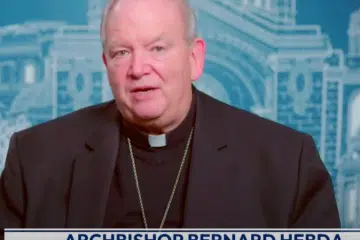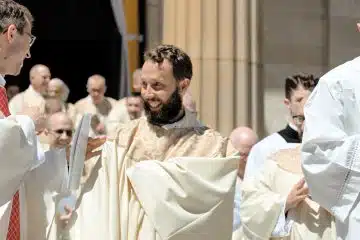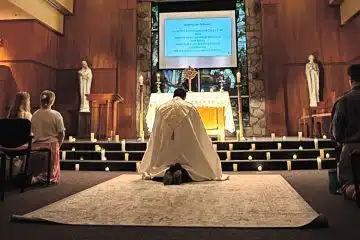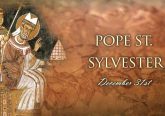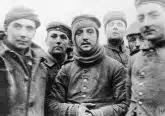Will these African Americans be canonized?
Denver Newsroom, Aug 13, 2022 / 06:00 am
Among the many Black men and women who have been declared saints in the Catholic Church, not one of them — yet — has been American. But that does not mean there aren’t numerous good candidates for the first African American saint in the Church’s history.
Here are just a few of them. The men and women featured here are the subjects of a documentary, “A Place at the Table: African Americans on the Path to Sainthood,” set to air on EWTN on Aug. 20, 2022 at 8 p.m. EST.
Venerable Pierre Toussaint
Toussaint was brought to New York from Haiti as a slave by his masters, the Bérard family. After the death of Mr. Bérard, Toussaint supported Mrs. Bérard financially out of Christian charity until she remarried.
He became a hairdresser at about the age of 20, while still enslaved by the Bérard family, and catered to New York’s high society. He was highly regarded for his professional abilities, but more importantly, because he would always listen to the problems of his clients with profound empathy, and with a supernatural perspective.
He and his wife Juliette—who had her own business—amassed significant wealth, but also gave generously, especially to Catholic ministries related to orphans. He was one of the main fundraisers for Saint Elizabeth Ann Seton’s orphanage in New York, even though at the time it only served white children.
Toussaint was also a generous donor to the Oblate Sisters of Providence—the first community of black religious—and supported their orphanage.
In 1991, Cardinal John O’Connor began the process for his beatification, and had Toussaint’s body exhumed and reinterred in St. Patrick’s Cathedral. He became the first layman to be buried in the crypt below the main altar.
In 1996, Toussaint was declared Venerable by St. John Paul II. He is the only layperson to be buried at St. Patrick’s Cathedral in New York City.
Servant of God Mary Lange
Elizabeth Clarisse Lange was of African descent and born in Santiago de Cuba. In the early 1800s, Lange migrated to the United States from Cuba, and settled in Baltimore, Maryland, a popular landing spot for other French-speaking Catholic Haitian refugees at the time. She arrived in the U.S. well-educated and with some money to her name, indicating that her parents were also educated and well-off.
Sharon Knecht, external coordinator for her canonization, noted that Lange faced fourfold difficulties: She was an immigrant in a nativist society, a woman in a patriarchal society, a Catholic in an anti-Catholic society, and Black in a largely racist society.
Lange was living in Baltimore by 1813, and soon after realized that the children of her fellow refugees were in desperate need of education, something that was hard to come by for black children in antebellum America.
Together with a friend, Marie Magdelaine Balas, Lange began offering free education to children of color from her home. In 1829, Lange founded not only the school but also a religious order of sisters for women of color. Lange and three other women took their first vows as Oblate Sisters of Providence. Lange, who became the superior of the order, took the religious name of Mary, and became known as Mother Mary Lange.
The school founded by the sisters, St. Frances Academy, is the oldest, continuously running school for black Catholics in the United States, and remains open today. By 1860, all children of color attending Catholic school in Baltimore were educated in schools run by the Oblate Sisters.
During her lifetime, Lange and her sisters not only educated children of color, but they housed orphans and vulnerable elderly, and took in extra washing and mending and begged on the streets to support those in their care. In 1832, the sisters also cared for the terminally ill during the cholera epidemic. After the Civil War, the sisters cared for dozens of black orphans who were living in Baltimore.
On February 3, 1882, after a long life of service to others, Mother Mary Lange died. Her sainthood cause was opened in 1991.
Venerable Henriette DeLille
Henriette DeLille was born in 1812 to a wealthy French father and a free Creole woman of Spanish, French, and African descent. Henriette was groomed throughout her childhood to become a part of the plaçage system, whereby free women of color entered into common law marriages with wealthy white plantation owners. But Henriette declared that her religious convictions could not be reconciled with the plaçage lifestyle for which she was being prepared. Raised Catholic, she believed that the plaçage system violated Church teaching on the sanctity of marriage.
Working as a teacher since the age of 14, Henriette’s devotion to caring for and educating the poor grew. Even though she was only one-eighth African and could have passed as a white person, she always referred to herself as Creole or as a free person of color, causing conflict in her family, who had declared themselves white on the census.
In 1836, wanting to dedicate her life to God, Henriette used the proceeds of an inheritance to found a small unrecognized order of nuns, the Sisters of the Presentation of the Blessed Virgin Mary. Her non-white heritage had barred her from admission to the Ursuline and Carmelite orders, which only accepted white women at the time. This group would eventually become the Sisters of the Holy Family, officially founded at St. Augustine’s Church in 1842. The Sisters taught religion and other subjects to slaves, even though it was illegal to do so at the time, punishable by death or life imprisonment.
Henriette Delille died in 1862 at age of 50, probably of tuberculosis. At the time of her death, her order had 12 members, but it would eventually peak at 400 members in the 1950s. The Sisters of the Holy Family are an active order in Louisiana today, with sisters working in nursing homes and as teachers, administrators and other pastoral positions.
Venerable Henriette Delille was the first U.S.-born African American to have a sainthood cause opened, according to her order.
Venerable Augustus Tolton
Although black Catholics had been a part of the Catholic community in the United States for over three centuries at that point, Father Augustus Tolton was the very first black Catholic priest in the United States. Throughout his life, he endured extreme racism, even from fellow Catholics, but never gave up on his faith.
Tolton was born into slavery in Monroe County, Missouri in 1854 and escaped to Quincy, Illinois with his family during the Civil War. Although Illinois had outlawed slavery in 1848, it was by no means a safe haven for escapees. This is true not only of the state as a whole, but also in the Catholic churches the Tolton family attended; the white parishioners in Illinois largely rejected their fellow black fellow Catholics.
The priest at Tolton’s parish approached the very bright young man and asked him if he had ever considered the priesthood. But Tolton faced a problem: Not one seminary in the United States to which he applied would accept him, because of his race. So instead he got the opportunity to study for the priesthood in Rome. He was ordained in 1889.
Father Tolton fully expected to be sent to minister in a different country— maybe even to Africa. But instead, the Vatican sent him back to the U.S., to the country that had up to that point rejected him, because the Vatican wanted people in the US to see a black priest. Tolton served for three years at a parish in Quincy, eventually accepting an invitation to come to Chicago where he led St. Monica Parish.
On July 9, 1897, Fr. Tolton collapsed during a hot day and died from sunstroke at the age of 43. A seminary set up in Baltimore by the Josephite religious order— whose charism is to minister to Black Catholics— opened not long after his death. Many young black Catholics saw the ministry of Father Tolton and were inspired to enter the seminary themselves.
His cause for canonization was launched in 2010, and he was given the title “Servant of God” by the Vatican in February 2011. The research phase of his cause concluded Sept. 29, 2014.
Servant of God Julia Greeley
Born a slave in Hannibal, Missouri sometime between 1833 and 1848, Julia Greeley was known for her remarkable charitable efforts, despite massive personal hardships and health issues.
After leaving the service of Colorado’s first territorial governor, Greeley found odd jobs around the city, and came upon the Sacred Heart Parish of Denver, where she would convert to Catholicism in 1880. She was an enthusiastic parishioner, a daily communicant, and became an active member of the Secular Franciscan Order starting in 1901. The Jesuit priests at her parish recognized her as a fervent promoter of devotion to the Sacred Heart of Jesus.
Despite her own poverty, Greeley spent much of her time collecting food, clothing, and other goods for the poor. She would often do her work at night, so as to avoid embarrassing the people she was assisting. Wearing a floppy hat, oversized shoes, and dabbing her bad eye — with a handkerchief, Greeley was often seen pulling her red wagon of goods to deliver to the poor and homeless of the city.
Julia Greeley died on June 7, 1918 – the feast of the Sacred Heart. Although her death came unexpectedly, she was able to receive last rites. It is estimated that she was around 80 years old, though because she was born into slavery, her exact age was never known. She is the only person buried in Denver’s Cathedral Basilica of the Immaculate Conception.
Servant of God Thea Bowman
The granddaughter of a slave, Thea Bowman was born Bertha Bowman in Yazoo City, Mississippi in 1937, to a doctor and a teacher. Though raised Protestant, she chose to become Catholic at age nine, and was moved by the kindness and generosity of the Franciscans Sisters of Perpetual Adoration, whose school she subsequently attended.
When she turned 15, she moved to Wisconsin and entered the order’s novitiate. Although her parents tried to persuade their daughter to enter an African-American community, she was determined to enter the Franciscan Sisters of Perpetual Adoration, whose warmth and love had drawn her to the Catholic faith six years prior.
At the time, she was the first and only black sister of the community in La Crosse. When she began teaching at a Catholic elementary school in La Crosse, Bowman would teach about racial diversity, and about the importance of love. She continued to be involved in the burgeoning civil rights movement, and helped to establish the National Black Sisters Conference and advocated for an increased representation of American-American people in Church leadership. She called for more encounters between white and non-white Catholics, and for a welcoming of music from different cultural backgrounds.
Bowman became a noted public speaker, and traveled around the country, talking about race and the Catholic faith, even after being diagnosed with breast cancer in 1984. She famously gave a speech before the U.S. bishops in 1989 and spoke about her identity as an African American Catholic as a “gift to the Church.”
Bowman died on March 30, 1990. The Diocese of Jackson opened her canonization cause in 2018.


